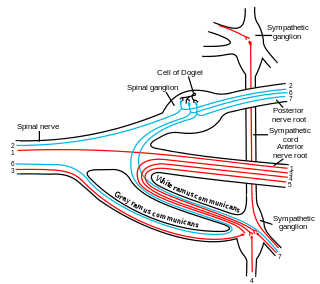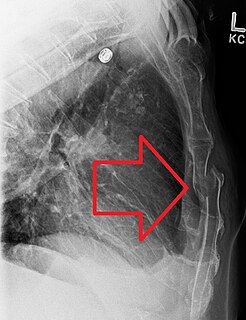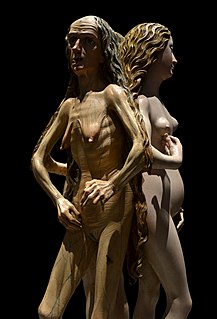Related Research Articles

Polyuria is excessive or an abnormally large production or passage of urine. Increased production and passage of urine may also be termed diuresis. Polyuria often appears in conjunction with polydipsia, though it is possible to have one without the other, and the latter may be a cause or an effect. Primary polydipsia may lead to polyuria. Polyuria is usually viewed as a symptom or sign of another disorder, but it can be classed as a disorder, at least when its underlying causes are not clear.
Arthralgia literally means joint pain. Specifically, arthralgia is a symptom of injury, infection, illness, or an allergic reaction to medication.

Nipple discharge is fluid from the nipple, with or without squeezing the breast. The discharge can be milky, clear, green, purulent, bloody, or faintly yellow. The consistency can be thick, thin, sticky, or watery.

Desipramine, sold under the brand name Norpramin among others, is a tricyclic antidepressant (TCA) used in the treatment of depression. It acts as a relatively selective norepinephrine reuptake inhibitor, though it does also have other activities such as weak serotonin reuptake inhibitory, α1-blocking, antihistamine, and anticholinergic effects. The drug is not considered a first-line treatment for depression since the introduction of selective serotonin reuptake inhibitor (SSRI) antidepressants, which have fewer side effects and are safer in overdose.

Nortriptyline, sold under the brand name Pamelor, among others, is a medication used to treat depression. This medicine is used for: neuropathic pain, attention deficit hyperactivity disorder (ADHD), smoking cessation and anxiety. As with many antidepressants, its use for young people with depression and other psychiatric disorders may be limited due to increased suicidality in the 18-24 population initiating treatment. Nortriptyline is a less preferred treatment for ADHD and stopping smoking. It is taken by mouth.
Nursing theory is defined as "a creative and rigorous structuring of ideas that project a tentative, purposeful, and systematic view of phenomena". Through systematic inquiry, whether in nursing research or practice, nurses are able to develop knowledge relevant to improving the care of patients. Theory refers to "a coherent group of general propositions used as principles of explanation".
Acephalgic migraine is a neurological syndrome. It is a relatively uncommon variant of migraine in which the patient may experience some migraine symptoms such as aura, nausea, photophobia, and hemiparesis, but does not experience headache. It is generally classified as an event fulfilling the conditions of migraine with aura with no headache. It is sometimes distinguished from visual-only migraine aura without headache, also called ocular migraine.

Protriptyline, sold under the brand name Vivactil among others, is a tricyclic antidepressant (TCA), specifically a secondary amine, indicated for the treatment of depression and attention-deficit hyperactivity disorder (ADHD). Uniquely among most of the TCAs, protriptyline tends to be energizing instead of sedating, and is sometimes used for narcolepsy to achieve a wakefulness-promoting effect.

The general visceral afferent (GVA) fibers conduct sensory impulses from the internal organs, glands, and blood vessels to the central nervous system. They are considered to be part of the visceral nervous system, which is closely related to the autonomic nervous system, but 'visceral nervous system' and 'autonomic nervous system' are not direct synonyms and care should be taken when using these terms. Unlike the efferent fibers of the autonomic nervous system, the afferent fibers are not classified as either sympathetic or parasympathetic.
Deconditioning is adaptation of an organism to less demanding environment, or, alternatively, the decrease of physiological adaptation to normal conditions. Decondition may result from decreased physical activity, prescribed bed rest, orthopedic casting, paralysis, aging, etc.

Testolactone is a non-selective, irreversible, steroidal aromatase inhibitor which is used as an antineoplastic drug to treat advanced-stage breast cancer. The drug was discontinued in 2008 and is no longer available for medical use.

A sternal fracture is a fracture of the sternum, located in the center of the chest. The injury, which occurs in 5–8% of people who experience significant blunt chest trauma, may occur in vehicle accidents, when the still-moving chest strikes a steering wheel or dashboard or is injured by a seatbelt. Cardiopulmonary resuscitation (CPR), has also been known to cause thoracic injury, including sternum and rib fractures. Sternal fractures may also occur as a pathological fracture, in people who have weakened bone in their sternum, due to another disease process. Sternal fracture can interfere with breathing by making it more painful; however, its primary significance is that it can indicate the presence of serious associated internal injuries, especially to the heart and lungs.
Functio laesa is a term used in medicine to refer to a loss of function or a disturbance of function.
An androgen-dependent condition, disease, disorder, or syndrome, is a medical condition that is, in part or full, dependent on, or is sensitive to, the presence of androgenic activity in the body.

An altered level of consciousness is any measure of arousal other than normal. Level of consciousness (LOC) is a measurement of a person's arousability and responsiveness to stimuli from the environment. A mildly depressed level of consciousness or alertness may be classed as lethargy; someone in this state can be aroused with little difficulty. People who are obtunded have a more depressed level of consciousness and cannot be fully aroused. Those who are not able to be aroused from a sleep-like state are said to be stuporous. Coma is the inability to make any purposeful response. Scales such as the Glasgow coma scale have been designed to measure the level of consciousness.
A draw sheet is a small bed sheet placed crosswise over the middle of the bottom sheet of a mattress to cover the area between the person's upper back and thighs, often used by medical professionals to move patients. It can be made of plastic, rubber, or cotton, and is about half the size of a regular sheet. It can be used in place of a mattress pad if a rubber mattress is used. The draw sheet may or may not be tucked into the sides of the bed. When a draw sheet is used to move patients, it is sometimes known as a lift sheet. Nursing manuals recommend that, when a plastic or rubber draw sheet is used, a cotton drawsheet is placed over it. If a folded sheet is used as a draw sheet, the folded edge of the sheet is positioned at the person's upper body. Draw sheets used as lift sheets are generally not tucked in, though sometimes after the move, they are.

Ethylketazocine (WIN-35,197-2), is an opioid drug of the benzomorphan family which has been used extensively in scientific research in the last few decades as a tool to aid in the study of the κ-opioid receptor. However, due to its relatively poor selectivity for the κ-opioid receptor over the μ- and δ-opioid receptors, as well as its relatively poor intrinsic activity at all sites, it has been mostly replaced in recent times by newer and more potent and selective compounds like U-50,488 and ICI-199,441.
An estrogen-dependent condition, disease, disorder, or syndrome, is a medical condition that is, in part or full, dependent on, or is sensitive to, the presence of estrogenic activity in the body.

Breast atrophy is the normal or spontaneous atrophy or shrinkage of the breasts.
Fundal massage, also called uterine massage, is a technique used to reduce bleeding and cramping of the uterus after childbirth or after an abortion. As the uterus returns to its nonpregnant size, its muscles contract strongly, which can cause pain. Fundal massage can be performed with one hand over the pubic bone, firmly massaging the uterine fundus, or with the addition of one hand in the vagina compressing the two uterine arteries. Routine use of fundal massage can prevent postpartum or post-abortion hemorrhage and can reduce pain; it may also reduce the need for uterotonics, medications that cause the uterus to contract. It is used to treat uterine atony, a condition where the uterus lacks muscle tone and is soft to the touch instead of firm.
References
- ↑ Aschenbrenner, Diane S. (2009), "Chapter 23: Drugs treating severe pain", in Aschenbrenner, Diane S.; Venable, Samantha J. (eds.), Drug therapy in nursing (3rd ed.), Lippincott Williams & Wilkins, pp. 373–398, ISBN 978-0-7817-6587-9
- ↑ Harper, Phil (13 December 2007 – 9 January 2008). "Postoperative pain: why are patients′ self-reports so unreliable?". Letter. British Journal of Nursing . 16 (22): 1375. doi:10.12968/bjon.2007.16.22.27765. PMID 18361384.
- ↑ Rosdahl, Caroline Bunker; Kowalski, Mary T. (2008). Textbook of basic nursing (9th ed.). Lippincott Williams & Wilkins. ISBN 978-0-7817-6521-3.
- ↑ "Remembering Margo McCaffery's Contributions to Pain Management". ONS Voice. Retrieved 2018-04-29.